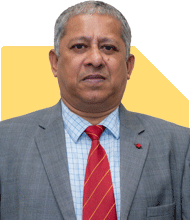Ramalingam Kalirajan |8192 Answers |Ask -Follow
Mutual Funds, Financial Planning Expert - Answered on May 20, 2024
He has an MBA in finance from the University of Madras and is a certified financial planner.
He is the director and chief financial planner at Holistic Investment, a Chennai-based firm that offers financial planning and wealth management advice.... more

I want to invest ?40,000 annually for a period of 20 years. Kindly suggest for a diversified portfolio which can help me to reach a corpus of 1.5 CR.
Understanding Your Financial Goals
Before we delve into constructing your investment portfolio, it's essential to understand your financial aspirations and risk appetite.
Analyzing Investment Horizon and Risk Tolerance
Given your investment horizon of 20 years and the desire to accumulate a corpus of ?1.5 crore, we can consider a moderately aggressive investment approach.
Constructing a Diversified Portfolio
A well-diversified portfolio helps mitigate risk and maximize returns over the long term. Here's a suggested allocation:
Equity Investments (70%)
Large Cap Funds: These funds invest in established companies with a track record of stable performance, providing a foundation of reliability to your portfolio.
Mid Cap Funds: With a higher growth potential, mid-cap funds offer the opportunity for substantial returns over the long term, albeit with higher volatility.
Small Cap Funds: Investing in smaller companies with significant growth potential, small-cap funds can contribute to enhancing your portfolio's overall returns.
Debt Investments (20%)
Corporate Bond Funds: These funds offer relatively higher returns than traditional fixed deposits while maintaining a degree of stability. They invest in bonds issued by corporations, providing a balance to the equity component.
Gold Investments (10%)
Gold ETFs or Gold Savings Funds: Gold acts as a hedge against inflation and market volatility, providing stability to your portfolio during economic uncertainties.
Benefits of Actively Managed Funds
Actively managed funds, as opposed to passive index funds, offer the advantage of professional fund management. Fund managers actively research and select stocks, striving to outperform the market and deliver superior returns to investors.
Risks of Direct Stock Investing
While direct stock investing may seem appealing, it requires a significant amount of time, knowledge, and effort to research and manage a well-diversified portfolio. Moreover, individual stocks carry higher volatility and risk compared to mutual funds.
Regular Funds vs. Direct Funds
Investing through a Certified Financial Planner (CFP) accredited Mutual Fund Distributor (MFD) offers several benefits, including personalized advice, portfolio monitoring, and access to a wide range of funds. Direct funds may offer slightly lower expense ratios but lack the personalized guidance provided by an MFD.
Conclusion
By following a disciplined investment approach and diversifying your portfolio across equities, debt, and gold, you can work towards achieving your financial goals. Remember to review your portfolio regularly, reassess your risk tolerance, and make adjustments as needed to stay on track.
Best Regards,
K. Ramalingam, MBA, CFP,
Chief Financial Planner,
www.holisticinvestment.in
You may like to see similar questions and answers below
Sanjeev Govila |458 Answers |Ask -Follow
Financial Planner - Answered on Feb 05, 2024
Ramalingam Kalirajan |8192 Answers |Ask -Follow
Mutual Funds, Financial Planning Expert - Answered on Jul 19, 2024
Ramalingam Kalirajan |8192 Answers |Ask -Follow
Mutual Funds, Financial Planning Expert - Answered on Sep 03, 2024
Dr Nagarajan Jsk |314 Answers |Ask -Follow
NEET, Medical, Pharmacy Careers - Answered on Apr 06, 2025
Dr Nagarajan Jsk |314 Answers |Ask -Follow
NEET, Medical, Pharmacy Careers - Answered on Apr 06, 2025
Dr Nagarajan Jsk |314 Answers |Ask -Follow
NEET, Medical, Pharmacy Careers - Answered on Apr 06, 2025
Dr Nagarajan Jsk |314 Answers |Ask -Follow
NEET, Medical, Pharmacy Careers - Answered on Apr 06, 2025
Dr Nagarajan Jsk |314 Answers |Ask -Follow
NEET, Medical, Pharmacy Careers - Answered on Apr 06, 2025
Radheshyam Zanwar |1519 Answers |Ask -Follow
MHT-CET, IIT-JEE, NEET-UG Expert - Answered on Apr 06, 2025
Dr Nagarajan Jsk |314 Answers |Ask -Follow
NEET, Medical, Pharmacy Careers - Answered on Apr 06, 2025
Dr Nagarajan Jsk |314 Answers |Ask -Follow
NEET, Medical, Pharmacy Careers - Answered on Apr 06, 2025
Dr Dipankar Dutta |1093 Answers |Ask -Follow
Tech Careers and Skill Development Expert - Answered on Apr 05, 2025
Prof Suvasish Mukhopadhyay |552 Answers |Ask -Follow
Career Counsellor - Answered on Apr 05, 2025





















